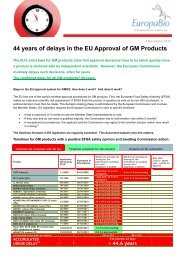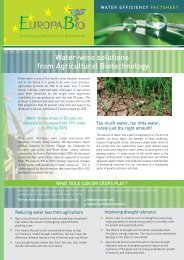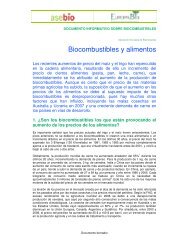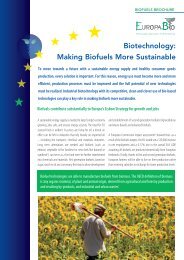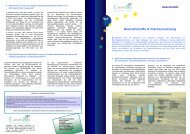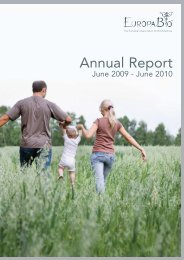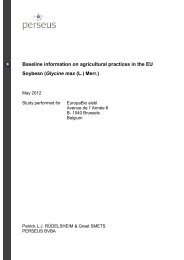GM crops: Reaping the benefits, but not in Europe - Europabio
GM crops: Reaping the benefits, but not in Europe - Europabio
GM crops: Reaping the benefits, but not in Europe - Europabio
Create successful ePaper yourself
Turn your PDF publications into a flip-book with our unique Google optimized e-Paper software.
4<br />
2. GLOBAL IMPACTS AT FARM LEVEL<br />
CAN 15 MILLION FARMERS BE WRONG?<br />
“You’re <strong>not</strong> go<strong>in</strong>g to spend money on a specific seed unless it has real <strong>benefits</strong>.”<br />
Paul Temple, UK farmer (2 March 2011, Brussels)<br />
In countries where farmers are allowed to grow <strong>GM</strong> <strong>crops</strong>, <strong>the</strong>y <strong>in</strong>creas<strong>in</strong>gly choose to do so. In 2010,<br />
15.4 million farmers <strong>in</strong> 29 countries cultivated <strong>GM</strong> <strong>crops</strong> 2 . This is more than twice <strong>the</strong> number of farms<br />
<strong>in</strong> <strong>the</strong> EU. Most of <strong>the</strong>se farmers stick to <strong>the</strong> technology once <strong>the</strong>y have tried it <strong>the</strong>mselves. 93% of<br />
Spanish farmers who grew <strong>GM</strong> maize <strong>in</strong> 2010 said <strong>the</strong>y would do aga<strong>in</strong> <strong>in</strong> 2011. In 2010, <strong>GM</strong> <strong>crops</strong> were<br />
cultivated on 148 million hectares worldwide, which is roughly equivalent to <strong>the</strong> comb<strong>in</strong>ed landmasses<br />
of France, Spa<strong>in</strong> and Germany. It is more than <strong>the</strong> entire area of arable land <strong>in</strong> <strong>the</strong> EU 3 .<br />
Global cultivation of <strong>GM</strong> <strong>crops</strong> – by crop<br />
million ha.<br />
160<br />
140<br />
120<br />
100<br />
80<br />
60<br />
40<br />
20<br />
0<br />
1996<br />
1997<br />
1998<br />
1999<br />
2000<br />
2001<br />
2002<br />
SOYA MAIZE<br />
COTTON<br />
RAPESEED<br />
Boost<strong>in</strong>g farm <strong>in</strong>come and production<br />
2003<br />
2004<br />
2005<br />
“Biotech <strong>crops</strong> can <strong>in</strong>crease productivity and (farmer) <strong>in</strong>come significantly, and hence, can serve as an<br />
eng<strong>in</strong>e of rural economic growth that can contri<strong>but</strong>e to <strong>the</strong> alleviation of poverty for <strong>the</strong> world’s small<br />
and resource-poor farmers.” 4<br />
Independent research <strong>in</strong>to <strong>the</strong> economic impacts of <strong>GM</strong> cultivation demonstrates clear <strong>benefits</strong>.<br />
The net global economic <strong>benefits</strong> at <strong>the</strong> farm level added by cultivat<strong>in</strong>g <strong>GM</strong> ra<strong>the</strong>r than conventional<br />
varieties have been estimated at $10.8 billion <strong>in</strong> 2009 – <strong>the</strong> equivalent of add<strong>in</strong>g 5.8% to <strong>the</strong> value<br />
of global production of <strong>the</strong> four ma<strong>in</strong> <strong>crops</strong> of soya beans, maize, cotton and rapeseed. Comb<strong>in</strong>ed<br />
<strong>benefits</strong> for a 14-year period (1996 to 2009) have been calculated at $64.7 billion 5 .<br />
<strong>GM</strong> <strong>crops</strong> have also made important contri<strong>but</strong>ions to <strong>in</strong>creas<strong>in</strong>g global production levels of <strong>the</strong> four<br />
ma<strong>in</strong> <strong>crops</strong>. To achieve <strong>the</strong> same level of production without <strong>the</strong> use of <strong>GM</strong>Os <strong>in</strong> 2009, an additional<br />
total area of 12.4 million hectares – equivalent to nearly <strong>the</strong> entire surface of England – would have<br />
been needed (<strong>in</strong>clud<strong>in</strong>g 5.6 million ha for maize and 3.8 million ha for soya beans) 5 . The enormous<br />
uptake <strong>in</strong> <strong>GM</strong> crop cultivation can only be expla<strong>in</strong>ed by <strong>the</strong> real and genu<strong>in</strong>e advantages that <strong>the</strong>se<br />
<strong>crops</strong> offer farmers.<br />
2006<br />
2007<br />
2008<br />
2009<br />
2010<br />
Source<br />
ISAAA



